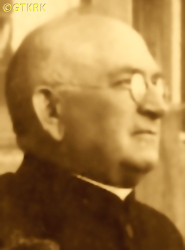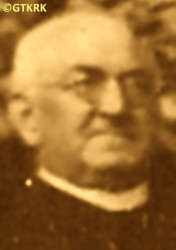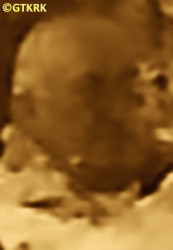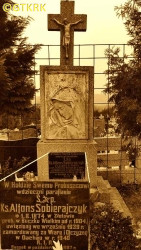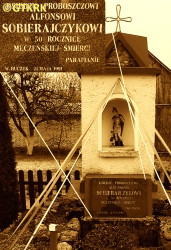Roman Catholic
St Sigismund parish
05-507 Słomczyn
85 Wiślana Str.
Konstancin deanery
Warsaw archdiocese, Poland
full list:
displayClick to display full list

searchClick to search full list by categories
wyświetlKliknij by wyświetlić pełną listę po polsku

szukajKliknij by przeszukać listę wg kategorii po polsku

Martyrology of the clergy — Poland
XX century (1914 – 1989)
personal data
surname
SOBIERAJCZYK
forename(s)
Alphonse (pl. Alfons)
function
diocesan priest
creed
Latin (Roman Catholic) Church RCmore on
en.wikipedia.org
[access: 2014.09.21]
diocese / province
Territorial Prelature of Schneidemühlmore on
en.wikipedia.org
[access: 2013.07.06]
Culm (Chełmno) diocesemore on
pl.wikipedia.org
[access: 2012.11.23]
date and place
of death
21.05.1941

KL Dachauconcentration camp
today: Dachau, Upper Bavaria reg., Bavaria state, Germany
more on
en.wikipedia.org
[access: 2016.05.30]
details of death
After German invasion of Poland on 09.1939 (Russians invaded Poland 17 days later) and start of the World War II arrested by the Germans on 12.09.1939, together with other members of Union of Poles in Germany.
Held in Złotów prison and from there taken to Albatros transit camp in Piła.
In 11.1939 moved to KL Sachsenhausen concentration camp.
Finally on 14.12.1940 transported to KL Dachau concentration camp where perished.
According to the death certificate, prepared in KL Dachau, the „honest” otherwise German „medical doctors” and formalists — and at the same time, unrivaled fairy tale spinners — noted that the cause of death was Germ. „Versagen von Herz und Kreislauf” (Eng. „Heart and circulatory failure”).
prisoner camp's numbers
22529Click to display source page (KL DachauClick to display the description)
cause of death
extermination: exhaustion and starvation
perpetrators
Germans
sites and events
KL DachauClick to display the description, KL SachsenhausenClick to display the description, ZL AlbatrosClick to display the description, «Intelligenzaktion»Click to display the description, Ribbentrop‐MolotovClick to display the description, Pius XI's encyclicalsClick to display the description
date and place
of birth
01.08.1874Birth certification on:
metryki.genbaza.pl
[access: 2025.09.08]

Złotówtoday: Złotów gm., Złotów pov., Greater Poland voiv., Poland
more on
en.wikipedia.org
[access: 2021.04.02]
parents
SOBIERAJCZYK Anthony
🞲 ?, ? — 🕆 ?, ?

OGRABISZEWSKA Pauline
🞲 ?, ? — 🕆 ?, ?
presbyter (holy orders)
ordination
1899

Pelplintoday: Pelplin gm., Tczew pov., Pomerania voiv., Poland
more on
en.wikipedia.org
[access: 2021.05.06]
positions held
1905 – 1939
parish priest — Wielki Buczektoday: Lipka gm., Złotów pov., Greater Poland voiv., Poland
more on
en.wikipedia.org
[access: 2022.07.16] ⋄ Holy Trinity RC parish
1903 – 1904
vicar — Luzinotoday: Luzino gm., Wejherowo pov., Pomerania voiv., Poland
more on
en.wikipedia.org
[access: 2021.09.02] ⋄ St Lawrence the Martyr RC parish ⋄ Mirachowotoday: Kartuzy gm., Kartuzy pov., Pomerania voiv., Poland
more on
en.wikipedia.org
[access: 2020.11.27] RC deanery
vicar — Starogard Gdańskitoday: Starogard Gdański gm., Starogard Gdański pov., Pomerania voiv., Poland
more on
en.wikipedia.org
[access: 2021.06.07] ⋄ St Matthew the Apostle RC parish ⋄ Starogard Gdańskitoday: Starogard Gdański gm., Starogard Gdański pov., Pomerania voiv., Poland
more on
en.wikipedia.org
[access: 2021.06.07] RC deanery
vicar — Przodkowotoday: Przodkowo gm., Kartuzy pov., Pomerania voiv., Poland
more on
en.wikipedia.org
[access: 2021.09.02] ⋄ St Andrew the Apostle RC parish ⋄ Gdańsk IIdeanery name
today: Gdańsk city pov., Pomerania voiv., Poland
more on
en.wikipedia.org
[access: 2021.07.04] RC deanery
vicar — Stężycatoday: Stężyca gm., Kartuzy pov., Pomerania voiv., Poland
more on
en.wikipedia.org
[access: 2021.09.02] ⋄ St Catherine of Alexandria the Virgin and Martyr RC parish ⋄ Mirachowotoday: Kartuzy gm., Kartuzy pov., Pomerania voiv., Poland
more on
en.wikipedia.org
[access: 2020.11.27] RC deanery
vicar — Radowiskatoday: Wielkie Radowiska, Dębowa Łąka gm., Wąbrzeźno pov., Kuyavia‐Pomerania voiv., Poland
more on
en.wikipedia.org
[access: 2021.09.02] ⋄ St James the Apostle RC parish
1899 – 1919
membership — Toruńtoday: Toruń city pov., Kuyavia‐Pomerania voiv., Poland
more on
en.wikipedia.org
[access: 2021.06.20] ⋄ scientific society
1894 – 1899
student — Pelplintoday: Pelplin gm., Tczew pov., Pomerania voiv., Poland
more on
en.wikipedia.org
[access: 2021.05.06] ⋄ philosophy and theology, Theological Seminary
others related
in death
BLESKEClick to display biography John, BUHLClick to display biography John, CZEKALLAClick to display biography Theophilus, GRABKEClick to display biography Leo, GROCHOCKIClick to display biography John, HELLWIGClick to display biography Francis, HUNDRIESERClick to display biography Paul Leo, KLEMTClick to display biography Leo, KÖNIGClick to display biography Robert, KRUGClick to display biography Maximilian, MERSMANNClick to display biography Alphonse, MICHALIKClick to display biography Herbert, REPKEClick to display biography Justus, RISSClick to display biography Francis, SCHADEClick to display biography John, STEINKEClick to display biography Eric, STEINKEClick to display biography Herbert, STRAUCHClick to display biography Emil, SZYNKOWSKIClick to display biography Francis, TETZLAFFClick to display biography Anthony, WINGERClick to display biography Leo, WITTIGClick to display biography Augustus
sites and events
descriptions
KL Dachau: KL Dachau in German Bavaria, set up in 1933, became the main German Germ. Konzentrationslager (Eng. concentration camp) KL for Catholic priests and religious during World War II: On c. 09.11.1940, Reichsführer‐SS Heinrich Himmler, head of the SS, Gestapo and German police, as a result of the Vatican's intervention, decided to transfer all clergymen detained in various concentration camps to KL Dachau camp. The first major transports took place on 08.12.1940. In KL Dachau Germans held approx. 3,000 priests, including 1,800 Poles. The priests were forced to slave labor in the Germ. „Die Plantage” — the largest herb garden in Europe, managed by the genocidal SS, consisting of many greenhouses, laboratory buildings and arable land, where experiments with new natural medicines were conducted — for many hours, without breaks, without protective clothing, no food. They slaved in construction, e.g. of camp's crematorium. In the barracks ruled hunger, freezing cold in the winter and suffocating heat during the summer, especially acute in 1941‐1942. Prisoners suffered from bouts of illnesses, including tuberculosis. Many were victims of murderous „medical experiments” — in 11.1942 c. 20 were given phlegmon injections; in 07.1942 to 05.1944 c. 120 were used by for malaria experiments. More than 750 Polish clerics where murdered by the Germans, some brought to TA Hartheim euthanasia centre set up in Schloss Hartheim in Austria and murdered in gas chambers. At its peak KL Dachau concentration camps’ system had nearly 100 slave labour sub‐camps located throughout southern Germany and Austria. There were c. 32,000 documented deaths at the camp, and thousands perished without a trace. C. 10,000 of the 30,000 inmates were found sick at the time of liberation, on 29.04.1945, by the USA troops… (more on: www.kz-gedenkstaette-dachau.deClick to attempt to display webpage
[access: 2013.08.10], en.wikipedia.orgClick to attempt to display webpage
[access: 2016.05.30])
KL Sachsenhausen: In Germ. Konzentrationslager (Eng. concentration camp) KL Sachsenhausen, set up in the former Olympic village in 07.1936, hundreds of Polish priests were held in 1940, before being transported to KL Dachau. Some of them perished in KL Sachsenhausen. Murderous medical experiments on prisoners were carried out in the camp. In 1942‐1944 c. 140 prisoners slaved at manufacturing false British pounds, passports, visas, stamps and other documents. Other prisoners also had to do slave work, for Heinkel aircraft manufacturer, AEG and Siemens among others. On average c. 50,000 prisoners were held at any time. Altogether more than 200,000 inmates were in jailed in KL Sachsenhausen and its branched, out of which tens of thousands perished. Prior to Russian arrival mass evacuation was ordered by the Germans and c. 80,000 prisoners were marched west in so‐called „death marches” to other camps, i.e. KL Mauthausen‐Gusen and KL Bergen‐Belsen. The camp got liberated on 22.04.1945. After end of armed hostilities Germans set up there secret camp for German prisoners and „suspicious” Russian soldiers. (more on: en.wikipedia.orgClick to attempt to display webpage
[access: 2018.11.18])
ZL Albatros: German transit Germ. Zivilgefangenenlager (Eng. camp for civilians) in Piła, operational in 09‐12.1939, mainly for Polish teachers and religious, who were treated especially rough, before transporting them to KL Sachsenhausen concentration camp, and for Jews. Prisoners were forced to slave in German manufacturing plants and local farms. Altogether more than 500 Poles were held captive there. (more on: pl.wikipedia.orgClick to attempt to display webpage
[access: 2019.11.17])
«Intelligenzaktion»: German: «Intelligenzaktion» (English: „Intelligence Action”) — a German program of extermination of the Polish elite, mainly the intelligentsia and leadership layers, carried out from the beginning of the occupation in w 09.1939 to 04.1940, mainly in territories directly annexed to Germany, but also in the so‐called Germ. Generalgouvernement (Eng. General Governorate), where it was called «AB‐aktion». In the first phase, immediately after the beginning of the German occupation, during military operations carried out by the Germ. Wehrmacht (Eng. Armed Forces) and the genocidal units of the Germ. Einsatzgruppen (Eng. Operational Groups) of the Germ. Sicherheitspolizei (Eng. Security Police), i.e. SiPo, and Germ. Sicherheitsdienst des Reichsführers SS (Eng. Security Service of the Reichsführer SS), i.e. SD, organized by the Germ. Reichssicherheitshauptamt (Eng. Reich Main Security Office), i.e. RSHA, which followed the troops, carried out under the Germ. Unternehmen „Tannenberg” (Eng. Operation „Tannenberg”) — based on the so‐called Germ. Sonderfahndungsliste (Eng. Special Wanted Lists), i.e. proscription lists of Poles considered particularly dangerous to the Third Reich, prepared by the Zentralstelle II/P (Polen) unit of the German RSHA. Later, implemented by the German civilian occupation authorities and the genocidal unit of the Germ. Volksdeutscher Selbstschutz (Eng. Ethnic Germans Self‐Defense), whose members were Germ. Volksdeutsche (Eng. Ethnic Germans), i.e. representatives of the German minority in Poland. According to various sources, these lists, at the beginning of 09.1939, could have contained the details of 61,000—88,000 „dangerous” Poles — although these figures cannot be confirmed. In total, during this genocide, c. 50,000 teachers, Catholic priests, representatives of the landed gentry, freelancers, social and political activists, and retired military personnel were systematically and methodically murdered. Another 50,000 were sent to concentration camps, where only a negligible percentage survived. (more on: en.wikipedia.orgClick to attempt to display webpage
[access: 2014.10.04])
Ribbentrop‐Molotov: Genocidal Russian‐German alliance pact between Russian leader Joseph Stalin and German leader Adolf Hitler signed on 23.08.1939 in Moscow by respective foreign ministers, Mr. Vyacheslav Molotov for Russia and Joachim von Ribbentrop for Germany. The pact sanctioned and was the direct cause of joint Russian and German invasion of Poland and the outbreak of the World War II in 09.1939. In a political sense, the pact was an attempt to restore the status quo ante before 1914, with one exception, namely the „commercial” exchange of the so‐called „Kingdom of Poland”, which in 1914 was part of the Russian Empire, fore Eastern Galicia (today's western Ukraine), in 1914 belonging to the Austro‐Hungarian Empire. Galicia, including Lviv, was to be taken over by the Russians, the „Kingdom of Poland” — under the name of the General Governorate — Germany. The resultant „war was one of the greatest calamities and dramas of humanity in history, for two atheistic and anti‐Christian ideologies — national and international socialism — rejected God and His fifth Decalogue commandment: Thou shall not kill!” (Abp Stanislav Gądecki, 01.09.2019). The decisions taken — backed up by the betrayal of the formal allies of Poland, France and Germany, which on 12.09.1939, at a joint conference in Abbeville, decided not to provide aid to attacked Poland and not to take military action against Germany (a clear breach of treaty obligations with Poland) — were on 28.09.1939 slightly altered and made more precise when a treaty on „German‐Russian boundaries and friendship” was agreed by the same murderous signatories. One of its findings was establishment of spheres of influence in Central and Eastern Europe and in consequence IV partition of Poland. In one of its secret annexes agreed, that: „the Signatories will not tolerate on its respective territories any Polish propaganda that affects the territory of the other Side. On their respective territories they will suppress all such propaganda and inform each other of the measures taken to accomplish it”. The agreements resulted in a series of meeting between two genocidal organization representing both sides — German Gestapo and Russian NKVD when coordination of efforts to exterminate Polish intelligentsia and Polish leading classes (in Germany called «Intelligenzaktion», in Russia took the form of Katyń massacres) where discussed. Resulted in deaths of hundreds of thousands of Polish intelligentsia, including thousands of priests presented here, and tens of millions of ordinary people,. The results of this Russian‐German pact lasted till 1989 and are still in evidence even today. (more on: en.wikipedia.orgClick to attempt to display webpage
[access: 2015.09.30])
Pius XI's encyclicals: Facing the creation of two totalitarian systems in Europe, which seemed to compete with each other, though there were more similarities than contradictions between them, Pope Pius XI issued in 03.1937 (within 5 days) two encyclicals. In the „Mit brennender Sorge” (Eng. „With Burning Concern”) published on 14.03.1938, condemned the national socialism prevailing in Germany. The Pope wrote: „Whoever, following the old Germanic‐pre‐Christian beliefs, puts various impersonal fate in the place of a personal God, denies the wisdom of God and Providence […], whoever exalts earthly values: race or nation, or state, or state system, representatives of state power or other fundamental values of human society, […] and makes them the highest standard of all values, including religious ones, and idolizes them, this one […] is far from true faith in God and from a worldview corresponding to such faith”. On 19.03.1937, published „Divini Redemptoris” (Eng. „Divine Redeemer”), in which criticized Russian communism, dialectical materialism and the class struggle theory. The Pope wrote: „Communism deprives man of freedom, and therefore the spiritual basis of all life norms. It deprives the human person of all his dignity and any moral support with which he could resist the onslaught of blind passions […] This is the new gospel that Bolshevik and godless communism preaches as a message of salvation and redemption of humanity”… Pius XI demanded that the established human law be subjected to the natural law of God , recommended the implementation of the ideal of a Christian state and society, and called on Catholics to resist. Two years later, National Socialist Germany and Communist Russia came together and started World War II. (more on: www.vatican.vaClick to attempt to display webpage
[access: 2023.05.28], www.vatican.vaClick to attempt to display webpage
[access: 2023.05.28])
sources
personal:
www.przyjaznaedukacja.plClick to attempt to display webpage
[access: 2012.12.28], metryki.genbaza.plClick to attempt to display webpage
[access: 2025.09.08]
bibliographical:
„Biographical dictionary of priests of the Chełmno diocese ordained in the years 1821‐1920”, Henry Mross, Pelplin, 1995
„International Tracing Service (ITS), Bad Arolsen, GermanyClick to display source page”, Arolsen Archives
original images:
krajniacy.plClick to attempt to display webpage
[access: 2019.04.16], krajniacy.plClick to attempt to display webpage
[access: 2019.04.16], krajniacy.plClick to attempt to display webpage
[access: 2019.04.16]
LETTER to CUSTODIAN/ADMINISTRATOR
If you have an Email client on your communicator/computer — such as Mozilla Thunderbird, Windows Mail or Microsoft Outlook, described at WikipediaPatrz:
en.wikipedia.org, among others — try the link below, please:
LETTER to CUSTODIAN/ADMINISTRATORClick and try to call your own Email client
If however you do not run such a client or the above link is not active please send an email to the Custodian/Administrator using your account — in your customary email/correspondence engine — at the following address:

giving the following as the subject:
MARTYROLOGY: SOBIERAJCZYK Alphonse
To return to the biography press below:
 Click to return to biography
Click to return to biography








